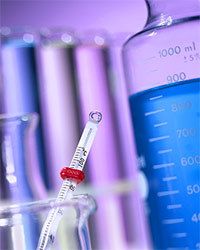Issels Immuno-Oncology Fever Therapy
The induction of fever under clinical conditions for therapeutic purposes.

Fever Therapy: Restoring Regulatory Mechanisms A Powerful Immune Enhancement
An Overview by Ilse Marie Issels
Fever therapy, or pyretotherapy, is the induction of fever under clinical conditions for therapeutic purposes. Clinical research suggests that fever is one of the body's most effective means to restore its complex regulatory, repair and defense mechanisms.
 Historically, Greek physicians of the antiquity used the curative effects of fever to treat a variety of diseases, including syphilis, tuberculosis, and others. However, modern linear-mechanistic thinking regards fever as a symptom of illness which has to be fought and suppressed. Fever is not recognized and therapeutically used any more as the (desirable) symptom of the body's fight against bacterial, viral, or other invaders, and self-generated dangers to health.
Historically, Greek physicians of the antiquity used the curative effects of fever to treat a variety of diseases, including syphilis, tuberculosis, and others. However, modern linear-mechanistic thinking regards fever as a symptom of illness which has to be fought and suppressed. Fever is not recognized and therapeutically used any more as the (desirable) symptom of the body's fight against bacterial, viral, or other invaders, and self-generated dangers to health.
There are many ways of raising the body's temperature. The most well known natural means are hot baths, steam baths, saunas, among others. The rise in body temperature achieved by these means is, however, not understood as fever. Neither is hyperthermia (originating from the Greek language "hyper" meaning "higher" or "excess" and "thermia" meaning "heat") called fever therapy. In hyperthermia treatment "excess heat" is directed to parts of the body or the whole body by the use of devices (e.g. microwave or ultra short wave).
Hyperthermia has become an adjunct weapon in the treatment of various cancers, as cancer cells are more sensitive to heat than healthy cells. It works by heat destruction, as well as by stimulating the immune system through heat-shock proteins that present on the surface of heat-treated cancer cells.
The raising of the body's temperature through the above mentioned means is artificially provoked from the outside, and may be called a "passive" fever. The term fever therapy applies when the body's "temperature control center" in the tuber cinereum of the mid brain is irritated by certain stimuli and induced to autonomically develop a febrile reaction: "active" fever.
Special herbal preparations such as mistletoe lectins, among others, biological autologous preparations (from the patient's own body tissues and fluids), biological homologous preparations, or mixed bacterial vaccines have been successfully used to induce fever.
William B. Coley, who was the Attending Bone Surgeon at Memorial Hospital, now Memorial Sloan Kettering Cancer Center, New York, from 1893 to 1936, pioneered fever therapy in cancer treatment. He observed that several sarcoma patients, and especially one patient suffering from recurrent inoperable sarcoma of the neck, experienced tumor remission after developing erysipelas, a superficial streptococcal infection of the skin accompanied by high fever.
He pursued his studies and developed a vaccine that became known as Coley's Mixed Bacterial Vaccine, MBV. These vaccines contain a combination of heat killed gram positive Streptococcus pyogenes and gram negative Bacillus prodigiosus, now called Serratia marcescens. In 1943, M.J. Shears, researcher at the National Cancer Institute, discovered that the biologically active substance in Coley's Mixed Bacterial Vaccine is lipopolysaccharide (LPS) that occurs in the cell walls of gram-negative bacteria.
Coley's Mixed Bacterial Vaccine and Fever Therapy
Coley's Mixed Bacterial Vaccine falls within the field of immunotherapy and have been gaining attention by cancer research. Administered intramuscularly or intravenously, depending on individual conditions of patients who qualify for this treatment, these vaccines induce fever for several hours, which subsides on its own.
During the rise of the fever, patients experience chills and feel flu-like symptoms, such as headache, back pain, or nausea and pain or tenderness in the tumor area. Tumors may swell slightly during the fever treatment and sometimes, a few days thereafter, patients notice already a reduction in tumor size.
Fever therapy by Coley's Bacterial Vaccine provokes a powerful reaction of the immune system. Research studies explain the anti tumor effect of Coley's Mixed Bacterial Vaccine through induction of interferon, augmentation of natural killer cell activity, stimulation of lymphoid tissues, activation of macrophages, induction of serum factor that causes necrosis of tumors, as well as stimulation of interleukin 2.
Fever therapy has not only a significant effect on the immune system, i.e. the constitutive lympho-reticular defense zone, but on all the defense zones, and especially the reticulo-histiocytary defense zone, i.e the pluripotent mesenchyme. This defense zone, also referred to as the "regulatory ground system" by Pischinger and Heine is the system of basic regulation.
It consists of the cells of the connective tissues, the fluid and semi-fluid of the extra cellular space, and the solid extra cellular matrix, also known as the ground substance whose properties vary with each specific type of connective tissue. Every cell is intimately linked to and depends on its surrounding medium: the extra cellular space, i.e. the extra cellular fluid from which it absorbs the nutrients and to which it releases the waste products of its metabolism.
The regulatory ground system fulfills many vital tasks, such as precursor cell function and formation of all types of blood cells; transit functions allowing communication and interactivity of nerves, blood cells, the lymph system, and organs; maintenance of homeostasis; detoxification; storage (of nutrients and toxins); and defense.
In view of its importance to all basic regulatory processes, the ground system plays a decisive role in the origin, prevention and treatment of chronic diseases and cancer. A prolonged disturbance of this system will result in a dysfunction of cells, organs and organ systems, and ultimately in an impairment of the repair and immune mechanisms.
In the case of cancer a malfunctioning immune system (immune surveillance) cannot properly detect and neutralize cancer cells that are a daily occurrence in every vertebrate organism. These cells can settle down at the site of least resistance and form a malignant tumor. Experience has shown, however, that restored regulatory, repair and immune functions can alter the medium, the extra cellular space surrounding the cancer cells, to an extent that induces cancer cells to re-differentiate, i.e. revert to normal cells. Normal healthy cells die when they have fulfilled their task. This programmed cell death is called apoptosis.
In disease prevention every effort should be made to avoid the persistence of noxious influences that will disturb the regulatory ground system. In chronic disease and cancer, experience indicates that therapeutic endeavors reach their optimum when they include measures that restore the proper functioning of the regulatory ground system.
One of these measures is fever therapy. During high fever, the internal environment of the body, on the cellular as well as the humoral levels, undergoes a fundamental change and all defensive and recuperative powers are brought to a high pitch.
 Febrile reactions stimulate the mobilization and elimination of metabolic residues and other unwanted deposits from the storage cells of the mesenchyme. They clear toxicants from latent congenital infections (e.g. TB), as well as from acute and chronic infections the body was not able or not allowed (overuse of antibiotics, steroids) to get rid of by developing an autonomic febrile reaction. These deposits, if not eliminated, reduce the storage capacity of the mesenchyme, and simultaneously the ability of immunocompetent tissues to react.
Febrile reactions stimulate the mobilization and elimination of metabolic residues and other unwanted deposits from the storage cells of the mesenchyme. They clear toxicants from latent congenital infections (e.g. TB), as well as from acute and chronic infections the body was not able or not allowed (overuse of antibiotics, steroids) to get rid of by developing an autonomic febrile reaction. These deposits, if not eliminated, reduce the storage capacity of the mesenchyme, and simultaneously the ability of immunocompetent tissues to react.
The pluripotent mesenchyme, i.e. the regulatory ground system, will become impaired in the fulfillment of its many vital tasks. A mesenchymal "block", in parallel with a lowering of the defense potential may result, which is considered by many authors as a major precondition for the development of chronic degenerative diseases and cancer.
Fever therapy has shown to be one of the most effective ways of cleansing the internal terrain, re-establishing homeostasis, lifting the "blockade" of the system of basic regulation, and restoring immune mechanisms to normal function.
Starting in 1951, in his hospital in Germany, Josef M. Issels, M.D. administered several 100,000 fever treatments without any adverse side effects or complications to thousands of his patients suffering from progressive metastatic cancer. Studies carried out in his hospital showed the remarkable immune enhancing effect of fever therapy.
One study involving the administration of mixed bacterial vaccines similar to Coley's Mixed Bacterial Vaccine compared the patients' white blood count of the morning before fever therapy with the count of 24 hours after the peak of the fever. The values rose temporarily, e.g. from 4,000 to 10,000, from 6,000 to 20,000 and from 9,000 to 40,000. They normalized gradually during the next few days.
Other studies at the Issels Hospital showed that in various types of advanced cancer, chemotherapy could be reduced by one third, sometimes half, of the commonly prescribed dosage with the same cytotoxic effect, when it was administered at the peak of the fever, thus considerably reducing toxic side effects.
Fever therapy has been and is now still an integral part of the comprehensive Issels Therapy.
Clinical research suggests that the restoration of the non-specific regulatory mechanisms of the ground system appears to be an important precondition for specific immunotherapy to reach its optimal effect.
References:
- Coley-Nauts, H., Fouler, G.A., M.D., Bogatko, F.H., M.D. "A Review of the Influence of Bacterial Infection and of Bacterial Products (Coley's Toxins) on Malignant Tumors in Men" 1953, Stockholm.
- Heine, H., M.D. "Matrix and Matrix Regulation" Significance of the extracellular matrix. Lecture at Biological Therapy Symposium, 1992, Lisbon, Portugal.
- Hoption Cann SA, van Netten JP, van Netten C
"Dr. William Coley and tumor regression: a place in history or in the future." Postgrad Med J 2003; 79:672-680. - Hoption Cann SA, van Netten JP, van Netten C, Glover DW "Spontaneous Regression: a hidden treasure buried in time." Med Hypotheses 2002; 58 (2):115-9.
- Hoption Cann SA, Gunn HD, van Netten JP, van Netten C "Spontaneous Regression of pancreatic cancer." Case Rep Clin Pract Rev 2004; 1.
- Heine H, M.D."Matrix and Matrix Regulation" Significance of the extracellular matrix. Lecture at Biological Therapy Symposium, 1992, Lisbon, Portugal.
- Issels J.M., M.D. "Cancer: A Second Opinion" 1999, New York, Avery Publ. Group ISBN 0-89529-992-5.
- MacAdam DH, "Spontaneous Regression: Cancer and the Immune System" Chapter two 'Coley', Xlibris:Philadelphia 2003.
- Wiemann, B., Starnes, Ch.O. "Coley's Toxins, Tumor Necrosis Factor and Cancer research: A Historical Perspective" 1994, Pharmac.Ther. Vol. 64, 529-564.
Published in 2002